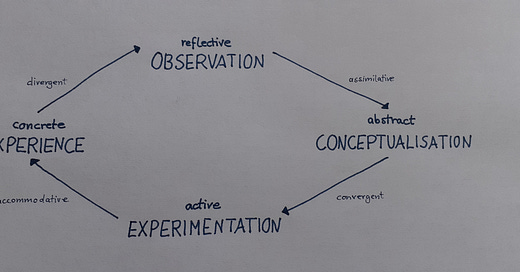Take 2 - Learning to 'Know Why'
Embedding Declarative Knowledge into Art and Design Teaching
The Take 2 posts are where I take another look at something I have written previously. The idea is to collect the main ideas, and possibly make at least parts of things that might be hidden behind various paywalls more accessible. (I realise that here they will also be hidden behind a paywall, but at least this one is mine, and it isn’t that high, so hopefully will be affordable.)
Today, I am focusing on an essay I wrote in 2009/10 as part of an assessment for the Post-Graduate Certificate of Higher and Professional Education I undertook quite some time ago. This has never been published in this format, although the core ideas have underpinned pretty much everything I have done in academia. I have slightly edited it from the original version and added some emphasis to words or phrases to make it read better, and replaced the images, because they didn’t play that well on Substack.
After the bibliography I have added a reflection from my current viewpoint - a 2023 take on this subject.
Learning to ‘Know Why’
Embedding Declarative Knowledge into Art and Design Teaching
In art and design education, and particularly in studio-based Higher Education courses, learners seem to perceive a division between theory and practice, a gap that programs often struggle to bridge. The contextual studies provision is attempting to build these bridges. However, one of the difficulties that has been encountered is that most students seem to be far more at home on the practice side, utilising learning strategies that are hands-on and based in skills-teaching, and struggle with modules that ask them to put this practical knowledge into a larger (and sometimes theoretical) context.
This problem can be linked to the distinction that educational scholars make between two different forms of knowledge: functioning and declarative. By looking at the difference between how these distinct forms of knowledge are taught (and learnt), this essay explores the potential of bridging the theory/practice gap between studio practice and contextual studies through a cross-over in teaching and learning strategies.
Two different kinds of Learning – two different kinds of Knowledge
Once the undergraduate degree course is started, students on practical art and design programs have two different kinds of learning experiences. On the ‘skills’ portion of their course one of the main learning strategies employed is experiential learning (Gray and Malins, 2004). No matter what skills students learn in the studio, they need to learn them by doing, through active, practical exploration. While teaching here is done through demonstrations, learning is done through working directly with the materials, trying out techniques and exploring processes. Students build up their practice through practicing. This type of work is usually based in a dedicated workshop space, where individual students are often allocated their own workplace for the year. By its very nature this type of learning tends to be active and informal.
‘Knowing how’ to produce an artefact located within the subject discipline, be that painting or animated film, lies at the heart of every practice based art and design course. This type of knowledge is skill-based and manual; and described by Biggs and Tang (2007) as ‘functioning’, while Cunliffe (2005) calls it ‘procedural’.
However, university degree courses are not simply about learning how to master specific skills, this learning is complemented by another type of knowledge, ‘declarative’ knowledge. This learning experience is quite different. It takes place not in the familiar workshops, but is set in lecture theatres and seminar rooms. The informal learning experience is squeezed into a much more formal format. This part of the course, contextual studies, seems not so much concerned with the skills of making, but rather with thinking, gathering information, and also with writing essays. This is difficult for students, especially in art and design, because some of them feel their strengths are based in the non-verbal spectrum.
Keep reading with a 7-day free trial
Subscribe to Tactile Academia and Beyond to keep reading this post and get 7 days of free access to the full post archives.



